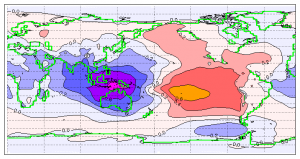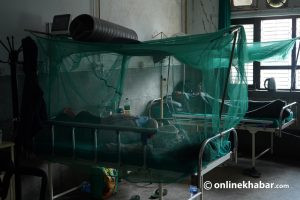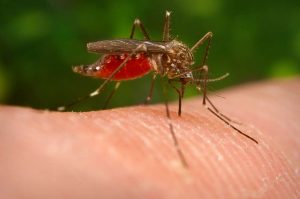
Mosquitoes were rare in the Kathmandu valley until 20 years ago. The infection of vector-borne diseases, once thought to be limited to the lowland Terai region, has risen higher and even reached highland areas in recent years. And this is a major challenge for the nation’s public health system.
The Epidemiology and Disease Control Division (EDCD) reports an increase in vector-borne diseases— malaria, elephantiasis, kala-azar, chikungunya, dengue, and scrub typhus—in Nepal every year as the rainy season approaches.
Reasons for the rise
According to public health experts, the increasing spread of such diseases is caused by climate change, human migration, rapid urbanisation, and the development of the ability of germs to survive at low temperatures.
Public health expert Dr Sharad Onta says the environment in hilly and mountainous regions is becoming more suitable for vector-borne diseases. “It was said that malaria does not emerge at an altitude of above 5,000 feet as the mosquitoes did not exist at that height. But, now, there are malaria patients in the Himalayan districts as well. This is a direct effect of climate change.”
Prof Dr Meghnath Dhimal, the research chief at the Nepal Health Research Council (NHRC) and a graduate in environmental health, also agrees. “Vector-borne diseases that appeared seasonally in yesteryear are now witnessed throughout the year in the Kathmandu valley. The reason for this is the rise in temperature and abnormal rain patterns.”
According to Dr Dhimal, the rate of increase in temperature is high in the districts of hills and mountains. Looking at the data of 30-40 years, due to the increase of more than 1.5 °C, mosquitoes are getting a favourable environment and growing. Scientists estimate that Nepal’s temperature will increase by 1.4 °C in 2030, 2.8 °C in 2060 and 4.7 °C in 2090, in comparison to 1968 to 1990.
Hence, there is some risk of dengue, cholera, and scrub typhus diseases throughout the year.
Dengue and malaria

Currently, dengue has become a major epidemic in the history of Nepal. Dengue, as a vector-borne disease, is caused by the bite of Aedes aegypti and Aedes albopictus mosquitoes. Aedes aegypti usually inhabit urban areas whereas Aedes albopictus is found in bushes and forests. However, there has been a change in the habitats of both these species, says Dr Gokarna Dahal, an epidemiologist.
Dengue was first reported in a foreign citizen in Chitwan, in 2004. Then in 2006, dengue cases were reported in some districts of Terai and inner Madhesh. In 2016, it was seen as an epidemic in Chitwan, Jhapa and Rupandehi. In 2019, dengue spread from Dharan and infected 18,000 people. It spread to 43 districts and killed 12 people. Since then, not only the number of people infected with dengue has gradually increased, but the number of districts affected has also gone up.
In 2022, more than 42,000 people have been infected with dengue and 52 people have died. This year, dengue has affected all 77 districts. This also shows how rapidly it has expanded from the lower (Terai) to the upper (mountainous) parts.
Since mosquitoes die at temperatures above 35 °C, the prevalence of vector-borne diseases, which was once considered to be epidemic in Terai, is gradually declining. However, specialists claim that dengue may easily spread even at 12 °C or 13 °C, therefore mosquito populations are rising in hilly and mountainous places.
According to the data of the EDCD, the number of dengue infected has increased by 20 times from 2010 to 2019 and almost 2.5 times from 2019 to 2022.
| Year | Number of dengue patients | Districts affected |
| 2019 | 17992 | 43 |
| 2020 | 530 | 43 |
| 2021 | 540 | 54 |
| 2022 | 41743 | 77 |
In 1970, more than 300 persons in Mugu got infected by malaria for the first time, which affected the settlements along the Karnali river.
According to the EDCD data, the number of malaria patients is gradually decreasing. However, the cases of malaria are increasing in the Himalayan region. “Eliminating malaria is our primary objective. Even now, there are yearly reports of infected cases in places like Kalikot, Baitadi, Darchula, and Mugu,” says Dahal.
Malaria is transmitted by Anopheles mosquitoes. The main cause of malaria is considered to be the parasite plasmodium. After entering the human body, they develop in the liver and red blood cells and then spread to different parts of the body through the blood. After this, people get various symptoms like headache, vomiting, swelling of internal organs, and fever. Malaria can be fatal in a short period if it is not treated on time.
Increasing scrub typhus
Contrary to malaria, scrub typhus, another vector-borne disease, was seen for the first time in Nepal in 2015 and it took a severe form in some children. But, according to studies by the Patan Academy of Health Sciences, this illness had also been present in Nepal prior to 2015 too.
According to government statistics, the majority of Nepal’s districts have seen scrub typhus in the seven years since the disease was first reported. Scrub typhus is caused by a bacterium called Orientia tsutsugamushi. This bacterium is transmitted from mice to humans by the chigger mite.
According to the EDCD, 1,610 people were infected with scrub typhus in 66 districts in 2019. By 2022, it spread to 71 districts.
The symptoms of scrub typhus appear within five to 20 days after being bitten by the chigger mite. High fever, excruciating headache, redness of the eyes, ringing in the ears, discomfort in breathing, body aches and rashes, swelling of the lymph nodes, sweating and the most important symptoms are small wounds or scabs caused by the bite of a chigger mite.
| Year | Number of scrub typhus patients | Districts affected |
| 2019 | 1610 | 69 |
| 2020 | 1754 | 58 |
| 2021 | 2017 | 68 |
| 2022 | 2576 | 71 |
The kala-azar cases
In the past, kala-azar, another major vector-borne disease that troubled Nepal, was not visible above 600 feet above sea level. However, in the fiscal year 2011/12, it was seen in Manebhanjyang of Okhaldhunga at an altitude of about 1,300 metres.
It was reported for the first time in the 1960s in Nepal.
In the next few years, the cases were sporadic. However, in recent years, the number of kala-azar patients has been increasing. Kala-azar has affected all the districts of the country.
The mite that transmits this vector-borne disease is only one-fourth the size of a mosquito. The body length of the mite is between 1.5 mm to 3.5 mm. Experts say that a temperature of 20 °C to 30 °C is suitable for the spread of kala-azar.
According to experts, there are two main reasons–import and domestic spread–for the spread of kala-azar in different places. Kala-azar, which was limited to 13 districts of the Terai until a few years ago, has now reached the Himalayas.
Kala-azar grows well in mud houses. The female mites transmit the disease while sucking the blood of animals or humans. It starts with mild fever and weakness and in a few weeks turns into a severe fever, anaemia, liver pain, irritability, black skin, swollen belly, and weakness. If not treated in time, it can be fatal.
| Year | Number of kala-azar patients | Districts affected |
| 2019 | 204 | 50 |
| 2020 | 215 | 50 |
| 2021 | 257 | 49 |
| 2022 | 240 | 41 |
Government’s challenge and ways to overcome
The first programme of Nepal’s fight against malaria, a historically significant vector-borne disease, is about to reach its 100th anniversary. But, some 400 cases of infection have been seen this year as well. Dr Gokarna Dahal, the chief of the Vector-Borne Disease Section at the EDCD, says since such cases have been increasing in the Himalayan region in recent years and the death rate has been seen, it is a big challenge for prevention.
“The government’s goal was to reduce malaria to zero by 2022. But, after malaria cases are seen in the Himalayan region, the target has been postponed until 2025,” shares Dr Dahal.
The challenge has been added after kala-azar started appearing in Humla, Mugu, Dolpa, and Kalikot as the government was planning to eradicate this vector-borne disease by the end of 2020. However, due to various reasons, the target could not be met, says Dahal, “We have now decided to delay it to 2030. The challenge is seen every year in the Himalayan districts.”
Nepal needs more people to research and control vector-borne diseases, but entomologists who would work on them are not yet available. There is one assistant entomologist who is working at the Vector-Borne Disease Research and Training Centre, Hetaunda. An epidemiologist is needed to study, research, and make policies on public health. However, even the EDCD is run by experts from other fields.
The government has been conducting various programmes to control vector-borne diseases, but there are not many such programmes in mountainous and hilly districts. Dr Onta says that there is a need to change the Terai-centred policy.
Other public health experts also suggest that programmes to control vector-borne diseases should not be made targeting only a certain place. Dr Marasini says public health programmes and strategies should be improved according to the way diseases are changing.
This story was translated from the original Nepali version and edited for clarity and length.

























